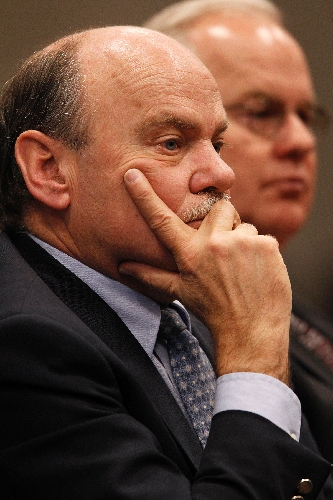Hispanics now largest student group in state

For the first time, Hispanics edged by Caucasians to become Nevada’s largest student group last year.
Of Nevada’s 437,057 students in 2010-11, Hispanics accounted for 38.8 percent of the enrollment, or 169,510 students. That’s 0.1 percentage point more than Nevada’s 169,128 Caucasian students, said Keith Rheault, Nevada superintendent of public schools.
The Nevada Department of Education released its 2010-11 Report Card of all districts and schools late Monday, also revealing that 55 percent of Nevada’s 680 public schools failed to meet the requirements of the federal No Child Left Behind law, which annually deems schools passing or failing based on student test scores in math, English and writing. The state, now on the federal watch list, made the grade the previous year.
The statewide trend follows the pattern set by the Clark County School District, which announced in early August that two-thirds of its schools failed No Child Left Behind. In light of those numbers, the state’s failure isn’t surprising, Rheault said. Clark County is by far the largest school district in Nevada, serving 70 percent of the Silver State’s students.
Hispanics surpassed white students as the largest group in Clark County schools in 2006 and represent a growing demographic, now making up 42 percent of district students. Caucasians account for 32 percent of district students.
Statewide, blacks made up 9.9 percent of student enrollment, Asians accounted for 6 percent, American Indian/Alaskan natives were 1.2 percent and Pacific Islanders were 1.1 percent. Multiracial students made up 4.3 percent of Nevada’s total enrollment.
Shifting demographics and the record number of schools falling short under No Child Left Behind weren’t the only firsts reported by the state Monday.
The Nevada Department of Education partially released its first “growth model” results for this year’s Nevada Report Card. The growth model is just for students in fourth to eighth grades for now but is planned to replace the federally mandated No Child Left Behind education reform. The growth model focuses more on student improvement throughout the school year instead of just testing proficiency annually and being deemed either passing or failing.
For example, less than half of Clark County and Nevada’s eighth-graders tested as proficient in reading or science in the last school year. A little more than half were proficient in math.
The growth model would focus less on those numbers and more on each student’s rate of growth. Is each student improving at a school year’s pace even if they’re technically not proficient?
“That gives them hope instead of being beaten down all the time because they failed No Child Left Behind,” said Rheault, adding that the growth model credits schools for showing academic improvement even if they don’t reach the bar.
No Child Left Behind doesn’t recognize that.
“It’s all or nothing,” said Randy Boone, chairman of the Department of Teaching and Learning within the University of Nevada, Las Vegas’ College of Education.
Boone said educators and soon-to-be educators are closely following the possible change because it looks like the growth model is how they’ll be judged.
That remains to be seen. No Child Left Behind’s rating system showing adequate yearly progress is still in place and will be until the state applies to opt out and replace it with the growth model in 2012-13. The application must receive federal approval.
These first-year results for grades four through eight are just a dry run, showing the U.S. Department of Education of what the state plans for all grades, Rheault said. Results can’t be used for “punitive” actions, he said.
Growth model results will be available by district and school at first. In coming months, they will be broken down by student to be used in parent-teacher conferences, Rheault said.












